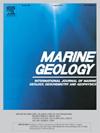印度西缘北格里比沉积磁性增强
IF 2.6
3区 地球科学
Q2 GEOSCIENCES, MULTIDISCIPLINARY
引用次数: 0
摘要
陆架地区的沉积磁性记录包含复杂的环境演变信息,需要来自全球不同地区的记录才能准确解释其意义。我们分析了从阿拉伯海东部取回的沉积岩芯(SSD-39/GC-01),以阐明地质和气候对沉积岩磁性和粒度特性的控制。我们首次报告了高能沉积物的记录,这些沉积物与强烈季风阶段、海平面变化以及北格里普时期(8.27 ka 至 4.20 ka)的极端自然事件有关。对印度西缘六个沉积岩芯的磁感应强度剖面进行汇编后发现,存在多个磁感应强度增强的沉积区间,很可能反映了受区域地质和气候过程控制的高沉积事件时期。我们确定了两个沉积磁异常区(Z-II、Z-IV),其特点是磁铁矿含量和沉积物粒度增大,反映了果阿大陆架的高沉积期。磁性矿物成分、碎屑粒度、碳酸钙和有机碳含量在 ∼1.8 ka(Z-I)发生变化,表明季风强度发生了突变。Z-Ⅰ中有机碳含量的升高表明,由于沉积物的快速沉积,易氧化的有机物得以有效保存。通过对岩石磁性和粒度特性进行末段建模,我们能够区分并量化陆相通量和沉积后矿物相对大体磁性矿物组合的贡献。我们证明,快速扫描沉积物岩心的磁感应强度有可能精确检测到大陆(磁通量)输入海洋陆架系统增加的时期。拟议的磁性矿物学方法具有更广阔的空间,可以制约对全球陆架沉积如何应对过去地质和气候条件的理解。本文章由计算机程序翻译,如有差异,请以英文原文为准。
A Northgrippian sedimentary magnetic enhancement along the western margin of India
Sedimentary magnetic records of shelf region contains complex environmental evolution information, necessitating records from various global regions to accurately interpret its significance. A sediment core (SSD-39/GC-01) retrieved from the eastern Arabian Sea was analyzed to elucidate the geologic and climatic controls on the sediment rock magnetic and grain size properties. We report the first record of high energy sediment deposits linked with intense monsoon phases, sea level variations, and extreme natural events during the Northgrippian period (8.27 ka to 4.20 ka). The compilation of magnetic susceptibility profiles of six sediment cores from the western margin of India revealed the presence of multiple sedimentary intervals of enhanced magnetic susceptibility and most likely reflect periods of high sedimentation events controlled by the regional geologic and climatic processes. We identified two anomalous sedimentary magnetic zones (Z-II, Z-IV) marked by an elevated magnetite content and sediment grain size, which reflect the periods of high-sedimentation events on the shelf off Goa. A shift in the magnetic mineral composition, clastic grain size, calcium carbonate, and organic carbon content at ∼1.8 ka (Z-I) indicate a abrupt change in monsoon intensity. The elevated organic carbon content within Z-I indicates efficient preservation of labile organic matter which survived oxidation due to rapid sediment deposition. End-member modeling of rock magnetic and grain size properties enabled us to discriminate and quantify the contributions of terrigenous fluxes and post-depositional mineral phases to the bulk magnetic mineral assemblage. We demonstrate that rapid scanning of magnetic susceptibility of sediment cores has the potential to precisely detect the periods of increased continental (magnetic flux) inputs into the marine shelf system. The proposed magnetic mineralogical approach has wider scope to constrain the understanding of how shelf sedimentation responded to past geological and climatic conditions globally.
求助全文
通过发布文献求助,成功后即可免费获取论文全文。
去求助
来源期刊

Marine Geology
地学-地球科学综合
CiteScore
6.10
自引率
6.90%
发文量
175
审稿时长
21.9 weeks
期刊介绍:
Marine Geology is the premier international journal on marine geological processes in the broadest sense. We seek papers that are comprehensive, interdisciplinary and synthetic that will be lasting contributions to the field. Although most papers are based on regional studies, they must demonstrate new findings of international significance. We accept papers on subjects as diverse as seafloor hydrothermal systems, beach dynamics, early diagenesis, microbiological studies in sediments, palaeoclimate studies and geophysical studies of the seabed. We encourage papers that address emerging new fields, for example the influence of anthropogenic processes on coastal/marine geology and coastal/marine geoarchaeology. We insist that the papers are concerned with the marine realm and that they deal with geology: with rocks, sediments, and physical and chemical processes affecting them. Papers should address scientific hypotheses: highly descriptive data compilations or papers that deal only with marine management and risk assessment should be submitted to other journals. Papers on laboratory or modelling studies must demonstrate direct relevance to marine processes or deposits. The primary criteria for acceptance of papers is that the science is of high quality, novel, significant, and of broad international interest.
 求助内容:
求助内容: 应助结果提醒方式:
应助结果提醒方式:


